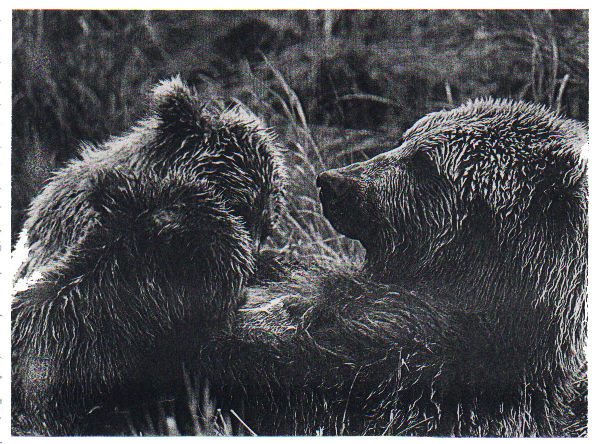 Marshall
Cultural Atlas Marshall
Cultural Atlas
This collection of student work is from
Frank Keim's classes. He has wanted to share these works for others
to use as an example of Culturally-based curriculum and documentation. These
documents have been OCR-scanned. These are available
for educational use only.
Higuma
Japanese Brown Bear
Japan is a crowded country with a population of 122 million
people. With Japan's population there is enough wilderness to support
nearly 3,000 Brown bears and an unknown number of Asian black bears.
Brown bears are found only in Japan's northernmost island, Hokkaido.
This island has a little more than 30,000 square miles and has nearly
four times the Brown bear population of the entire continental United
States!
The land began being cleared about 150 years ago when agriculture
and industry were introduced. Aboriginal Ainu had lived there by
hunting bears and deer, catching salmon, and gathering plants for
more than 1,000 years. The Ainu did not have any guns to kili these
big animals. They used only bamboo arrows poisoned with a preparation
made from the roots of a small purple-flowered plant called Aconitum
yesoense. Hunters tested the poison for these bamboo arrows by
putting it on the web between their fingers. If the poison was strong
enough they would feel a burning sensation. After the bear was hit it
would only run about 50 to 100 yards before falling. Each Ainu
village would give thanks by bringing the bear to the mountain god
after they had a four day -long ceremony or winter festival. Before
the festival though they'd capture a Brown bear cub and raise it for
two years. As it grew the women would take turns nursing the cub from
their breast. About 20 years ago the Japanese government no longer
let the ceremonies go on. Only a mock festival is held for tourists
to prevent the old ways from being lost.
Japanese consider the Brown bears to be dangerous pests for eating
their livestock and sometimes killing mushroom pickers in the
mountains. In 1915, after the killing of eight people and a baby, Yen
awards were given out for killing the bears. Awards up to 20,000 Yen
are still given out for nuisance bears in some communities.
Their future does not look good because of the loss of their
natural forest habitat. It is being cut down for both farm land and
for forest products. Bears can't even go fishing now because the
rivers the salmon live near are under human control and they are
closed to the bears.
Noako Maeda, the curator of the Noboribetsu Bear Park,
in the city of Noboribetsu, is deeply interested in the bears of Hokkaido.
She
said," the bear's young cubs suckle very gently, more so than her own
children." She hopes that the bears raised in the park will soon be
released to the wild.
By: Barbara Andrew

Higuma
Bear Fire
Stories and Poems
about Bears
|
by Marshall High School
Language Arts Classes
Spring, 1992
Produced
by
Information
about Bears
Creative
Stories from the Imagination
True
Stories from Experience
Poems
Christmastime Tales
Stories real and imaginary about Christmas, Slavik, and the New Year
Winter, 1996 |
Christmastime Tales II
Stories about Christmas, Slavik, and the New Year
Winter, 1998 |
Christmastime Tales III
Stories about Christmas, Slavik, and the New Year
Winter, 2000 |
| Summer Time Tails 1992 |
Summertime Tails II 1993 |
Summertime Tails III |
| Summertime Tails IV Fall, 1995 |
Summertime Tails V Fall, 1996 |
Summertime Tails VI Fall, 1997 |
| Summertime Tails VII Fall, 1999 |
Signs of the Times November 1996 |
Creative Stories From Creative Imaginations |
| Mustang Mind Manglers - Stories of the Far Out,
the Frightening and the Fantastic 1993 |
Yupik Gourmet - A Book of
Recipes |
|
| M&M Monthly |
|
|
| Happy Moose Hunting! September Edition 1997 |
Happy Easter! March/April 1998 |
Merry Christmas December Edition 1997 |
| Happy Valentine’s
Day! February Edition
1998 |
Happy Easter! March/April Edition 2000 |
Happy Thanksgiving Nov. Edition, 1997 |
| Happy Halloween October 1997 Edition |
Edible and Useful Plants of Scammon
Bay |
Edible Plants of Hooper Bay 1981 |
| The Flowers of Scammon Bay Alaska |
Poems of Hooper Bay |
Scammon Bay (Upward Bound Students) |
| Family Trees and the Buzzy Lord |
It takes a Village - A guide for parents May 1997 |
People in Our Community |
| Buildings and Personalities of
Marshall |
Marshall Village PROFILE |
Qigeckalleq Pellullermeng ‘A
Glimpse of the Past’ |
| Raven’s
Stories Spring 1995 |
Bird Stories from Scammon Bay |
The Sea Around Us |
| Ellamyua - The Great Weather - Stories about the
Weather Spring 1996 |
Moose Fire - Stories and Poems about Moose November,
1998 |
Bears Bees and Bald Eagles Winter 1992-1993 |
| Fish Fire and Water - Stories about fish, global warming
and the future November, 1997 |
Wolf Fire - Stories and Poems about Wolves |
Bear Fire - Stories and Poems about Bears Spring,
1992 |
|